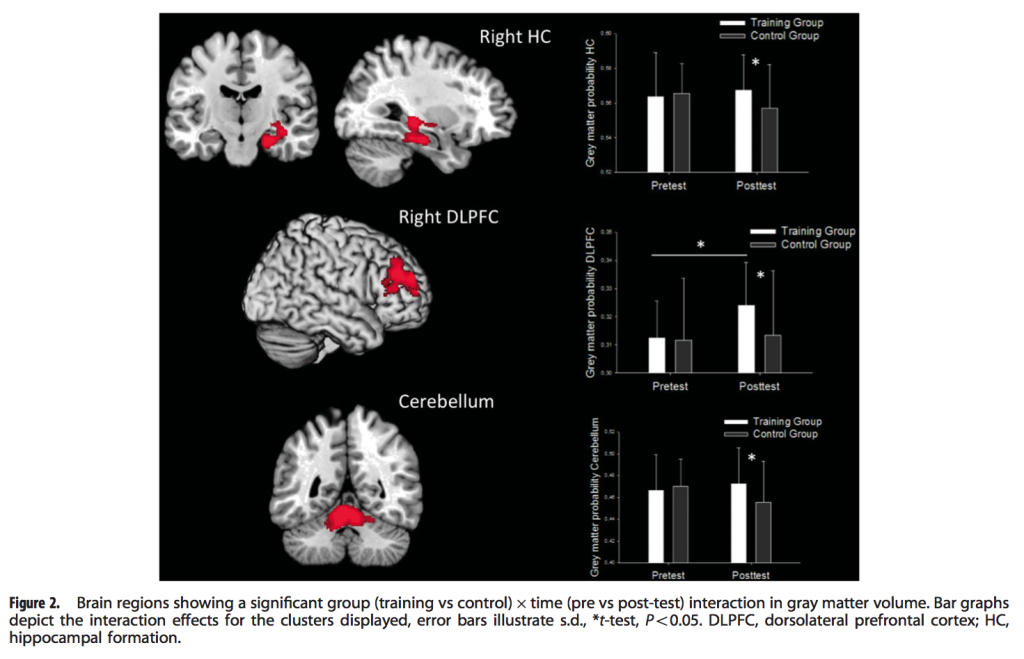
Some of the elves in our neck of the woods like to go on a trip to Mushroom Kingdom from time to time, just to relax and boost their abilities you understand. Unfortunately being able to double in size or become invincible hasn’t happened in real life yet, but a recent study has looked at whether playing Super Mario can alter the structure of the brain (Kühn et al, 2014).
As playing computer games is a different experience to doing something else, it is inevitable that the brain will change to reflect this, but working out the detail of the changes will be important to better understand the brain. If playing the game can improve some key cognitive processes, it may offer a fun intervention to complement other treatments for people who are struggling with mental health problems.
How video gaming, and spending long periods of time in front of screens, changes us has been a source of big controversy. Although there are a few high profile critics of modern technology (see Susan Greenfield on screen technologies), many research papers have suggested that playing computer games can have a positive effect on a range of motor, perceptual and cognitive abilities. How much these improvements on tests lead to better performance in day to day life skills is an ongoing debate, but in some studies it definitely does (Boot et al, 2011). One message seems to be: if you are going to have an operation using keyhole surgery, ask for a surgeon who has played a lot of computer games!
Methods
Researchers in Germany (Kühn et al, 2014) recruited 48 people who had not played any computer games for the previous 6 months and had never played Super Mario 64. They randomised them into 2 groups:
- 23 played Super Mario for at least 30 mins everyday
- 25 were just asked not to play any computer games during the study
Nobody in the study had had any mental health problems in the past and the study lasted 2 months.
The version of Super Mario used is important (and not only to my gaming obsessed pal who insisted I was very, very clear about this issue in the blog). Participants played Mario 64 on the handheld Nintendo DS XXL console. I’ve never read a research paper before that included the line: ‘a 3D platformer game where a princess has to be saved’ but that sums up the objective of the game nicely. To complete the game you need to solve puzzles and navigate around a 3D environment. You can move freely through the world and there are two screens that show Mario’s view from behind and a birds eye view map (see figure 1). Learning navigational strategies is crucial.
The participants had two 3T MRI brain scans before and after the game playing. They also did a number of questionnaires but we’ll focus on the imaging findings here. Unlike many of the studies done before on a similar topic, the researchers did the analysis at a whole brain level. This means that rather than deciding in advance which areas of the brain they think might change (a region of interest approach), they look at the whole brain and allow the statistics to decide which areas are important/significant. In general we should be very cautions about region of interest (ROI) structural imaging studies: they make it more likely there is a false positive and ignore the data from the rest of the brain. This study used one of the good quality whole brain approaches.
Results
The main results are shown in figure 2.
Three areas in the brain increased in size in the group who played Super Mario:
- Right hippocampus
- This area is much bigger in London cabbies and the changes seen here are likely to reflect navigational learning in the game
- Cerebellum
- The increase here is likely to be due to the visual-motor learning in order to play the game
- Right Dorsolateral Prefrontal Cortex (DLPFC)
- The DLPFC is involved in many cognitive processes. At the most basic level just learning when new behaviours are appropriate is likely to be changing this area of the brain.
Sum up
- 30 mins of Super Mario 64 a day, changed the structure of the brains of the study participants
- The areas that increased in size are consistent with existing ideas about what those areas do
- Smaller hippocampi and DLPFCs have been found in a range of mental disorders including depression and schizophrenia
- This might reflect a reduction in new experiences whilst suffering a high load of distressing symptoms
- The control group did not do anything similar, so the results may just reflect learning a new skill
- But other computer games have been shown to change other parts of the brain (Tetris has different effects, except in the DLPFC)
- Video game training could help some people improve their abilities
- But what the game does, and what skills you need to play it will be crucial in deciding what might help
-

If you’re human, steer clear of the red and white mushrooms. We elves gain great power from them, but they’ll just make you feel very icky
Links
Kühn S, Gleich T, Lorenz RC, Lindenberger U, Gallinat J. Playing Super Mario induces structural brain plasticity: gray matter changes resulting from training with a commercial video game. Molecular Psychiatry 19, 265-271 (February 2014) doi:10.1038/mp.2013.120 [Abstract]
Boot WR, Blakely DP, Simons DJ. Do action video games improve perception and cognition? Front Psychol. 2011 Sep 13;2:226. doi: 10.3389/fpsyg.2011.00226. eCollection 2011.
Super Mario graffiti image appears courtesy of: 1000 Words / Shutterstock.com




30 mins of ‘Super Mario’ a day enlarges brain structures http://t.co/8X9Kt9boxZ A new mental health intervention!
Super Mario changes your brain: Some of the elves in our neck of the woods like to go on a trip to Mushroom Ki… http://t.co/ldBAgrWpWx
Today @andrewwatson28 considers why playing Super Mario induces structural brain plasticity http://t.co/eZ3aFggbTW
Mental Elf: Super Mario changes your brain http://t.co/cYu7qgf9K2
Super Mario changes your brain – The Mental Elf http://t.co/OgSuYvfqWL
Super Mario changes your brain http://t.co/Py1sCOdZ04 via @sharethis
Could playing video games help people with depression or schizophrenia? Read our blog: http://t.co/eZ3aFggbTW
Paper contains line ‘a 3D platformer game where a princess has to be saved’ MT @Mental_Elf: Super Mario changes brain http://t.co/39O1ixMrZS
Playing video games could help people with depression or schizophrenia, a new study suggests.
http://t.co/lbUoMKZerx
New study in @MolPsychiatry investigates gray matter changes resulting from playing Super Mario http://t.co/eZ3aFggbTW
RT @Mental_Elf: Could some action video games improve our perception and cognition? http://t.co/eZ3aFggbTW
It’s our first blog about mushrooms, brain plasticity and video gaming, but we’re (fairly) sure it won’t be our last http://t.co/eZ3aFggbTW
At first sight, this looks like yet another under-powered fMRI paper. It commits the cardinal statistical sin of writing P < 0.05 in Figure 2 (see http://www.dcscience.net/?p=6518 )
RT @Mental_Elf: Don’t miss: Super Mario changes your brain http://t.co/eZ3aFggbTW The question is for the better or worse?
“@Mental_Elf: Gamers! This is your brain on Super Mario http://t.co/NyOQmgsvrg” #gaming #gamerproblems #supermario
Will video games turn your kids’ brains to mush, or might they have a positive impact? http://t.co/eZ3aFggbTW
@Mental_Elf I insist you use a head clutcher, harrumph! ;-D
Next time someone sees you playing Super Mario 64, say you’re working out your hippocampus: http://t.co/yHMUc6Apst
RT @Mental_Elf: Gamers! This is your brain on Super Mario http://t.co/eZ3aFggbTW
Rageh Yasser El-Siagy Mohamed Reda Mohab Mohamed :D :D http://t.co/cYWhIrFu4R
@t_pk How can I get this blog out to the gaming community? This is your brain on Super Mario http://t.co/eZ3aFggbTW
@Mental_Elf made you a list @t_pk/gaming
This is your brain on Super Mario http://t.co/eZ3aFggbTW @gamasutra @edgeonline @gameinformer @IGN @joystiq @Kotaku @gamespot @t_pk
Super Mario changes your brain. We can change the structure of our Brian’s through specifics activities http://t.co/50pcLNFSaA
Super Mario changes your brain http://t.co/JNVS92G6cC from the fab @Mental_Elf
How playing 30 mins of Super Mario 64 a day changes the brain http://t.co/KUqoH9Ekoj fascinating post from @mental_elf HT @anniecoops
@PaulBromford @Mental_Elf I’ve gor a feeling this might get more boy tweets than girl but maybe sterotyping ;)
Super Mario changes your brain – The Mental Elf http://t.co/5fxqyZhaDp < one for you @TarquinColes @Simon_CFLP
I think children over the world will be delighted with this research! (Not so sure about the parents though)
[…] Les omtalen i The Mental Elf her […]
Incredibly interesting read on the positive correlation between the motor cognition demanded by video games and the effects they have on the gamer’s brain.